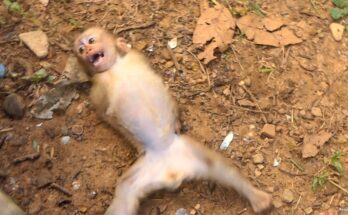Why Is the Monkey Doing This? So Strange and Painful to Watch – Please God Help!
There’s something instinctively disturbing about misbehavior in creatures far removed from human expectations. We think of monkeys as playful, inquisitive beings—bananas, swinging through trees, mischievously watching us from behind foliage. So when we witness a monkey engaging in baffling, even painful, behavior—sometimes self‑harming, sometimes frantic—our hearts hurt. That’s exactly the emotional surge this title taps into. It’s a raw plea from a witness—or perhaps the monkey itself—begging for mercy, help, understanding. Why is it happening?
First, let’s consider how we anthropomorphize animals. We project our emotions, needs, pains onto them because, at some level, we empathize. We hear frantic cries of “Please God help!” and we imagine suffering. We envision that monkey crying out in bewilderment: “Why my arm? Why this cut? Why can’t I stop?” We identify with its fight‑or‑flight impulses, its vulnerability. The pain becomes our pain.
Then comes the strangeness. Monkeys engaging in self‑injurious or disoriented conduct—biting, scratching, rocking—trigger alarm because they violate our mental image of a carefree, agile animal. We fear something’s gone catastrophically wrong: illness, psychological trauma, captivity, injury, parasitic infection. We wonder: is it confusion? Fear? Deep frustration? We’re shocked, unsettled, helpless.
If the under‑the‑surface human thinking in the title is “somebody do something,” it reflects both compassion and rage—rage at whoever or whatever inflicted this pain. Rage at captivity, human negligence, research labs, or poachers. Rage at unseen forces: disease, environment, neglect. It’s a cry of moral outrage: “This isn’t right. Someone must save it. Someone must help.”
The second layer: the viewer’s guilt. Our voyeurism feels wrong. Watching suffering… is it compassion or cruelty? The title grabs us because we can’t not watch—you and I want to know more. We want to see, understand, stop it. We feel implicated. We tweet, we comment, we share—“Please God help!” becomes a hashtag. We gain attention, yet the monkey continues to suffer on-screen. It’s strange—painful—to watch.
And yet… change requires attention. Public outrage brings awareness. Perhaps this video exposes monkey trafficking, or research gone wrong, or local mistreatment during capture or transport. We hope someone will intervene—vets, rescue teams, veterinarians, animal‑rights activists. “Why is the monkey doing this,” we demand, like forensic epidemiologists unpicking a trauma puzzle. Behavioral experts may comment: self‑bite is sometimes a sign of extreme stress or neurological disorder. Steroids? Neurological infection? Encephalitis? PTSD from capture? All are possible.
The emotional crescendo—the title’s hook—is that immediate human plea: “Please God help!” We realize medical treatment, veterinary care or compassionate rehabilitation can help. We realize sometimes you can help, but it takes resources, will and public pressure. This kind of title pushes us from passive viewers to moral agents. It wakes ethical instincts: “I must share. I must act.”
Still, there’s caution: viral sensationalism has downsides. Viral suffering videos can retraumatize the animal and harm viewers. Yet the title mixes pathos with alarm, forcing our eyes open. Ultimately, what stops this pain isn’t clicks—it’s real-world intervention. Medical treatment, sanctuary, legislation changes, enforcement of wildlife protections. Justice could take years; sometimes, irreparable harm is done before attention even arrives.
So why is the monkey doing this? We don’t yet know. Perhaps the video’s description—or a follow-up—reveals rescue efforts, veterinary intervention, or the outcome. Until then, the title stands as a plea: strange, painful, heart-wrenching—and a call to our shared humanity. “Please God help,” we whisper. And then… perhaps we must become that help.


